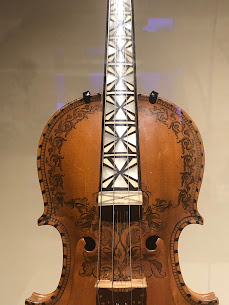You Can't Get Lost - Day 20 (March 18, 2022)
Yesterday, Loraine sent me a text with an attachment for an exhibit at the Musical Instrument Museum here in Phoenix. We went there five years ago and saw a special exhibit on inlay work on guitars and banjos. It was fascinating. People have spent years doing inlays on some instruments. And then the rest of the museum is wonderful, with exhibits of instruments from cultures and countries around the world.
The attachment Loraine sent of the current exhibit was "Treasures: Legendary Musical Instruments". It was about usually old, rare and one-of-a-kind instruments and more modern instruments by unique builders. I said yes within 30 seconds of receiving the text.
Today, we went. We got there at 1:00 sharp and walked into the exhibit. My guess there were 50 or so instruments in three rooms. The first instrument you walked into when you entered the exhibit space was a baroque guitar, the second oldest one in the world. To give you an idea of how intense I was about this guitar, I took 25 pictures, and didn't get one of the whole instrument, all 25 were details.

 This is a panorama view stitched from two photos. Why would I take 25 pictures of this instrument? Because I said I wanted to build one after I retired. I've met the time requirement, now it up to doing it. Notice that there are five courses or pairs of strings. The frets are made from gut and can be moved up and down the neck for different temperaments.
This is a panorama view stitched from two photos. Why would I take 25 pictures of this instrument? Because I said I wanted to build one after I retired. I've met the time requirement, now it up to doing it. Notice that there are five courses or pairs of strings. The frets are made from gut and can be moved up and down the neck for different temperaments. 













Wow, how wonderful! I can't wait to see your 1500's guitar replica when it is done. Thanks for sharing!
ReplyDelete